Dressing the 18th Century Lady
Below are pictures showing the stages in dressing for an 18th century lady. This style of outfit would have been called an 'undress' since it is informal clothing that a woman might have worn around the home or amongst friends informally. Clothing suitable for social events would be described as 'dress clothes'. For example ladies attending court would be told to appear 'fully dressed'.
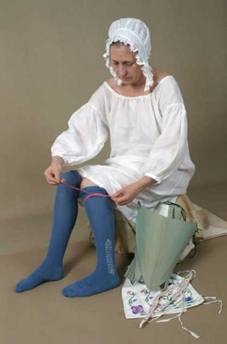
All women in the 18th century wore a 'shift' next to the skin to keep the upper layers of clothing clean from the body's dirt. It was usually made from linen but could be made of cotton or 'Scotch cloth' - a fabric made from the fibres of nettles.
Here the lady is tying garters to hold up her stockings. Stockings had designs known as 'clocks' worked at the ankle, which can just be seen here in white on the lady's left ankle. Her stays, pockets and a spare pair of garters lie close by.
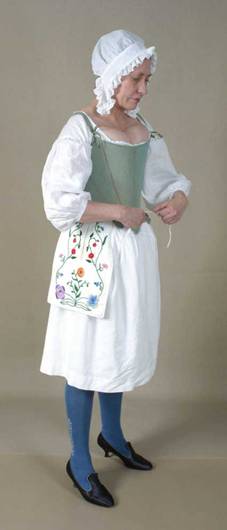
After tying her garters and putting on a short under petticoat - called a dickey in England - she is laced into her stays. To see more of these stays visit the stays page.
The lady is now tying a pair of pockets about her waist which will contain all she needs to carry about with her such as money, keys, fan, handkerchief, etc.
An English nursery rhyme mentions pockets:
Lucy Lockett lost her pocket
Kitty Fisher found it.
There was nothing in it
but a ribbon tied around it.
Because the pockets were simply tied about the waist the knot could come undone and the pockets fall to the floor, which is what happened to Lucy Lockett.
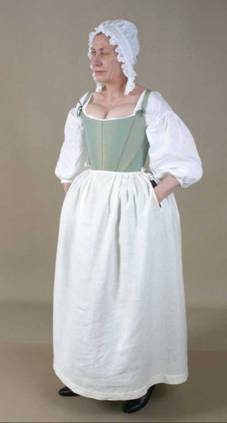
The pockets could be reached through slits left in each layer of petticoat. In the 18th century a woman's skirts were referred to as petticoats. The word skirts usually only referred to the lower parts of a man's waistcoat or coat.
Here the lady has put on her false rump or bum - a pad worn about the hips to give the skirt a fashionable shape. Over this she is wearing a quilted petticoat and then one of linen.
The usual method of making petticoats was to sew together several panels of fabric to obtain the desired width. The fabric was then shaped at the waist edge to fit over the rump or hoop that was to be worn. Finally the fabric was pleated to the size of the waist.
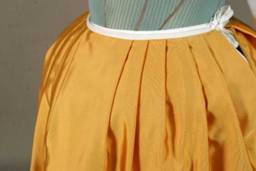
A flat panel was usually left over the belly with 2.5 cm/1" wide knife pleats facing to the side seam. A narrow tape was then sewn over the raw edge of the fabric to act as a waistband.
Here you can see the knot above the pocket slit where the petticoat fastens. Gathering was rarely, if ever used for petticoats and skirts in the 18th century. The flat pleats stop the fullness of the petticoat moving about as happens with drawstring waists.
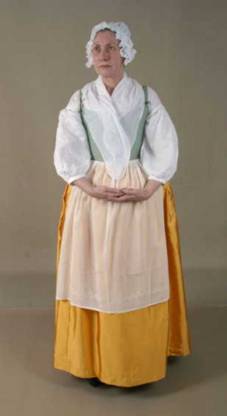
A petticoat of stiff ribbed silk has now been put on, together with an apron and a half neck handkerchief. Later in the century the handkerchief was known as a fichu.
For normal day wear a handkerchief would be worn to fill in the neckline providing warmth and protection from the sun. A suntan was not fashionable in the 18th century and usually indicated that the person had to work outside for a living.
For more dressy events in the evening it was normal to remove the handkerchief and show the cleavage.
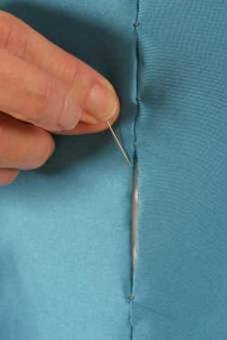
Finally, a jacket bodice is put on to complete the outfit. In this example it is made of blue silk and fastens down the centre front with pins.
Pins were the usual fastening for women's clothes in the 18th century although lacing, hooks and eyes and buttons were also used to a lesser degree.
If the pins are put in properly it is very rare for them to come undone and of course the lady is safe from stabbing herself because of the whalebone stays worn beneath.
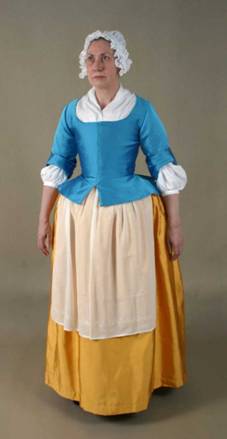
Ladies of several different classes could have worn an outfit like this. It might have been informal dress for a lady of rank at home in the country or her morning dress when not expecting visitors at her London house.
The fine embroidered muslin apron showed that the wearer did not expect to do any manual work and is inverted snobbery.
Even today people spend a lot on designer jeans to show their wealth despite the fact that jeans were (and still are) working clothes.
A ladies maid or upper servant could also have worn these clothes and in the mid century there are lots of comments about how well servants were dressed in England. Finally, if made in wool or linen this style of petticoat and jacket was often worn by working women.
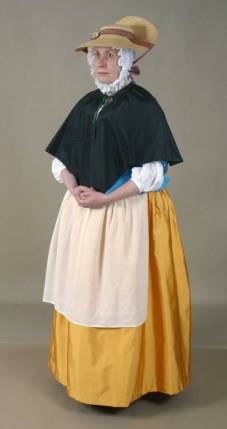
Before going out shopping or visiting, the lady would put on a cloak and hat. Here the lady is wearing a short cloak of black silk taffeta but in the 18th century a garment of any length or fabric worn around the shoulders could be called a cloak.
The 'kissing strings' or 'bridles' of the cap have been pinned together under the chin. In earlier pictures these have been worn pinned up onto the head out of the way in an alterative fashion. Through out the century hats for women usually have a very shallow crown and start to be cocked up behind like this by the early 1750's.
